If you properly heat the stove with wood, you can reduce fuel consumption by 15-20%, improve heat transfer and prevent increased soot formation in the chimney. The service life of the oven depends on compliance with the recommendations.
What kind of wood is better to heat the stove
As general rule, manufacturers indicate that for the oven better firewood non-coniferous hardwoods. When burned, the wood does not emit resin, it maintains the required combustion temperature. An additional plus, minimal soot deposition on the inner walls of the chimney.It is not recommended to heat the stove with pine and spruce wood, garbage. If necessary, peat and wood briquettes or sawdust are used as an alternative. The optimum moisture content of the fuel is 20%, which corresponds to the annual storage of firewood in a dry room.
What kind of wood is best for firewood
Wood of different species, differs in calorific value and characteristics of combustion. Therefore, when deciding what type of fuel the furnace will be fired with, the operating and other characteristics of the selected firewood are taken into account:In addition to the already listed types of wood, peat briquettes are popular. The advantage of briquettes is that there is no need for splitting, drying and any other preparation for combustion.
As an alternative to lump wood, sawdust can be used. Kindling is carried out with wood. After the fire has flared up, sawdust is added to the furnace at the rate of no more than 30% of the total volume of fuel.
What kind of wood to heat to clean the chimney
From time to time, it is recommended to carry out chimney prophylaxis, removing soot and tar deposits from the inner cavity. This is necessary for the following reasons: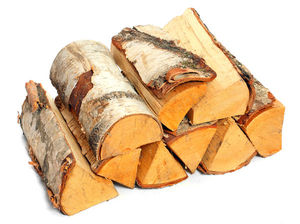
Prevention of the condition of the chimney is performed in several ways. If the deposits are small, burn aspen firewood (analogous to alder). The stove is well heated. Some craftsmen bring the combustion mode to such an intensity that there is a hum in the pipes. In addition to firewood, special chemical briquettes are burned.
Burning off the resin is effective preventive measure, but it does not help if the deposits inside the chimney have reached critical values. In such cases, mechanical pipe cleaning will be required.
Is it possible to heat a wood-burning stove with coal
You can decide what to heat with, coal or wood, by answering a few questions: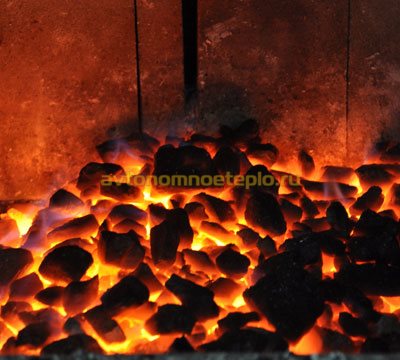
The temperature in the oven when burning wood is maintained at the level of 300-350 ° С, rarely, the heating rises to 450 ° С. The combustion temperature of coal is much higher. Under certain conditions, the air in the firebox heats up to 1000-2000 ° C.
Furnace fire rules
In order to reduce the consumption of firewood and optimize the combustion process, certain rules for ignition and combustion are observed. To make kindling a little easier, a few recommendations will help:- The standard size of firewood - logs are placed in the stove, approximately 5 cm less than the length of the combustion chamber. If during the preparation of firewood, try to make the logs of approximately the same size, you can significantly facilitate the process of kindling.
- Correct laying - the logs are stacked so that there are gaps between them for free air passage.
- Wood moisture - the stove can be heated with damp wood, but a large amount of tar and smoke is emitted. Therefore, as general recommendation, there is a rule: it should be heated with dry fuel, with a moisture content of 20-25%.
How to properly melt the stove with wood
Kiln lighting is an art. If the fire is not properly melted and maintained, the temperature in the firebox will never exceed 40-50 ° C, which is not enough to heat the room.Kiln firing is carried out in several stages: 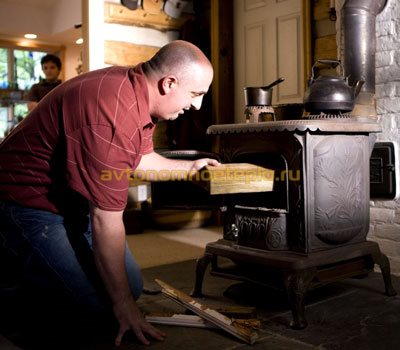
Heating with fuel briquettes is somewhat easier. Pressed firewood is laid out on the burnt seed. The calorific value of briquettes is higher than that of ordinary firewood, therefore, heating will take place faster by 20-30%.
How to heat the stove with raw wood
The cost of high-quality dry firewood is not so much higher that you can save a lot. But, if there are no other options, you can also light the stove with raw fuel.To light the stove with raw wood, follow a phased plan:
- Firewood is chopped into small pieces.
- The seed is made from small chips.
- Gradually begin to add larger fractions of wood.
- After the coals have appeared, you can add regular logs.
Raw birch firewood, it is better not to use it. When firing up, smoke and tar are released, which leads to a quick failure of the stove and the smoke exhaust system.
How to properly heat a brick oven in winter
A metal stove works equally smoothly in winter and summer. Precautions are required when operating a brick stove.A private bath is an unheated room that is often used once every few days. During this time, the masonry has time to cool and freeze. A similar situation is observed in country houses left without heating for a long period.
The burning temperature of wood in the stove is at least 300 ° C. Dry fuel burns, heating flue gases to 400-450 ° C. The temperature difference between frozen brick and burning wood leads to cracking of masonry and seams. As a result, after a season of operation, it will be necessary to make a major overhaul. brick oven.
To avoid unpleasant consequences, the firebox is performed slowly, allowing the walls to slowly warm up. Fuel filling should not exceed 30% of the total volume of the combustion chamber until the temperature of the masonry rises to the required one (the brick becomes warm). After that, the combustion will continue as usual.
How to properly heat the stove so as not to burn out
Carbon monoxide is a combustion product of wood that is contained in smoke. With proper operation of the stove, flue gases are discharged outside through the chimney. The ingress of carbon monoxide into the room is dangerous.In order not to burn out, you will need to follow several recommendations:
- It is forbidden to completely close the dampers and blower in order to increase the burning time of the wood.
- Before kindling, check the presence of traction.
- The firebox is heated up gradually, when heated chimney the thrust increases.
- Regular maintenance is carried out - if necessary, the chimney is cleaned, malfunctions are eliminated.
- They use high quality dry wood.
Be especially careful when using coal. During combustion, coal requires more oxygen than wood. After burning out the air in the firebox, the draft will deteriorate, carbon monoxide will go into the room.
When can you heat the stove after laying
It is impossible to heat the stove immediately after laying it. The brick is placed on a clay mortar. Clay hardens when heated. But, when overheated, it quickly loses moisture, strength and cracks.The brickwork is initially dried. They do it like this:
- It is important to avoid dampness in the firebox and smoke channels; for this, all doors and windows are opened, only after that the fire is lit.
- The work is performed at least 2-3 days after the end of the masonry work. The furnace is carried out for 0.5-1 hour not at full capacity. The oven is heated 2 times a day.
- As fuel, use finely chopped firewood, wood chips, shavings. You cannot drown with full-fledged logs.
- The forced drying process takes 4-6 days.
Calculation of the power and temperature of a warm water floor
Selecting the power of the air conditioner
It is a priori pleasant to contemplate a live fire in your stove, it creates a cozy and comfortable atmosphere throughout the house, but do not forget that its main task is to heat the room. Effective work stoves will allow you to warm up the space of the house at any time of the year, to kindle a bathhouse.
It is advisable that the kindling of the furnace does not take much time, and the heat from it, on the contrary, would be delayed for a long time. This can be done by choosing the right fuel, in particular firewood. In this article we will talk about what kind of wood is better to heat the stove, dwell on different types of wood, study deciduous and coniferous options and specific types of wood.
Nice burning fire in the stove
Firewood characteristics
It is not always appropriate to compare heating a house with a stove and electricity or gas, since the stove additionally creates an atmosphere of comfort, unique family coziness. How pleasant it is to hear the soft crackle of wood in the hearth in the silence of the thought, to feel the warmth emanating from it. Even in our time, these unique feelings are so pleasant to a person that a solid stove or a good fireplace is erected in almost every private house.
However, in order to effectively use the capabilities of the stove, you should understand the wood. It turns out that not all tree species are equally good for a firebox; there are many nuances that significantly complicate the choice of firewood for the stove.
For example, for burning in a fireplace, it is advisable to find wood that, when burning, exude a pleasant aroma, but do not emit a large amount of tar, soot, soot. Resins in the composition of wood contribute to increased smoke output, as well as explosive cracking of logs with the release of large coals. For an open fireplace, such emissions will be unsafe, therefore, coniferous wood is not used in them.
Firewood for the stove is selected according to heat transfer, their main criteria are the intensity and duration of combustion. It is desirable that the wood burns with less smoke and leaves behind a minimum of ash.
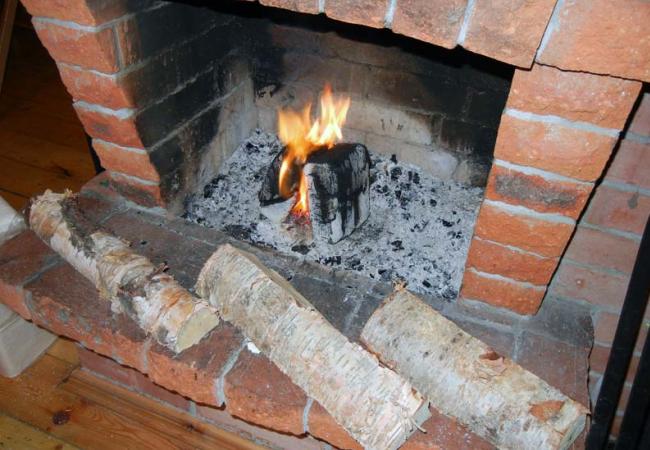
Wood to create fire
If we consider the optimal firewood for use in the oven, then they should have the following functionality:
- First of all, heat transfer, the highest possible for wood.
- The flammability of the tree should also be excellent, so that it would not be difficult to melt the hearth.
- When burning, firewood should not emit a lot of smoke and leave behind a small amount of ash.
To achieve such characteristics, it is important not only to choose the right type of wood species, but also to dry the harvested wood with high quality. Freshly cut wood is not used in ovens; to prepare it, it should be dried for some time, getting rid of excess moisture. Wet wood burns weakly, while emitting a large amount of smoke.
There is even a method for determining the sufficient dryness of wood for use in fireplaces or stoves. You should hit one log on another and listen to the sound. If it is sonorous, then it is quite possible to use such poleshki for heating the hearth.
It is believed that the best firewood for fireplaces and stoves is obtained if the logging is carried out during the winter period. At this time, the trees are in a certain conserved state, as a result of which sap flow practically does not work in them. Worst of all, if the firewood is harvested in spring or summer, when there is a lot of moisture in the wood, such a forest will dry for a very long time.
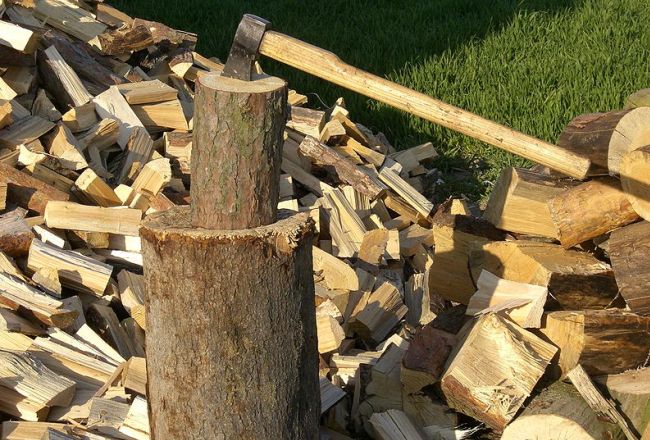
You can split firewood harvested in winter in summer
If we consider tree species, then it is best to choose deciduous options, since they have a fairly dense fiber structure. Such wood is capable of generating a large amount of heat for a long time. Most often, firewood is harvested from the following hardwoods: oak, birch, linden, alder, ash, aspen. Even fruit trees can be a good source of heat. In addition, the fragrant wood is perfect for use in a smokehouse or open fireplace.
Conifers also burn well, but since they contain a large amount of resin, they emit a lot of smoke and soot when burning. The needles burn quickly enough, but the heat is mediocre, therefore, for use in the oven at home, it is better not to consider this option too much, but.
Hardwood firewood
In order to optimally select firewood for a stove, based on specific needs, let's first consider the most popular types of deciduous trees for use in heating a house.
Oak firewood. Experts have long noted oak firewood as wood with almost maximum heat transfer (oak is inferior to ash). At the same time, burning of oak takes a long time, which can significantly reduce the consumption of logs. These characteristics of oak are due to its dense, solid structure. Naturally, oak firewood is more expensive than all others, but the savings are seen in the ability to heat the room with less fuel.
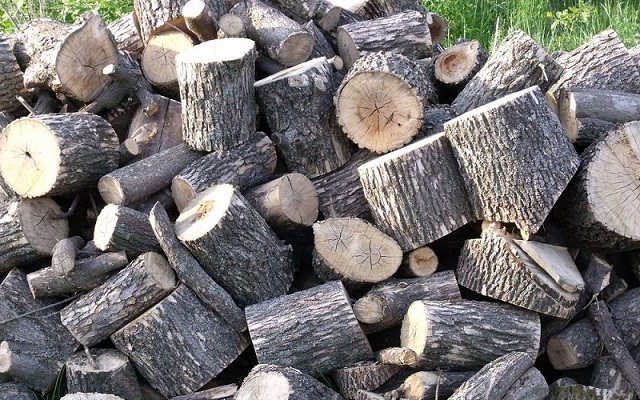
Harvesting oak wood
It is believed that a middle-aged oak should be used for harvesting, since it is at this time that its characteristics are maximum. When burned, such wood gives off a strong heat, as well as a very pleasant, characteristic forest aroma. Oak wood is actively used for stoking open fireplaces, they allow you to create a pleasant atmosphere in the room, filled with the healing aromas of the forest.
Interesting fact: a true Italian pizza on exclusively oak wood. Italy is not rich in this type of firewood, so oak wood is very valuable in this country.
Ash has similar characteristics, as well as fruit trees such as apple or pear, but they should also be harvested at a certain middle age.
Birch firewood. The next very popular wood we will look at is birch. Birch firewood is actively used for stoves in baths, since it not only gives an excellent heat and aroma, but is also endowed with disinfecting properties. In addition to this, the banya heated with birch wood is full of health-improving properties, it perfectly helps to cope with colds, chronic respiratory problems.
However, there are some nuances when harvesting birch. It has long been proven that firewood from this tree loses its main properties after 2-3 years of storage. This can be determined by outward appearance log, it becomes rotten. You should not expect a strong heat from such firewood, and the classic aroma from them completely disappears.
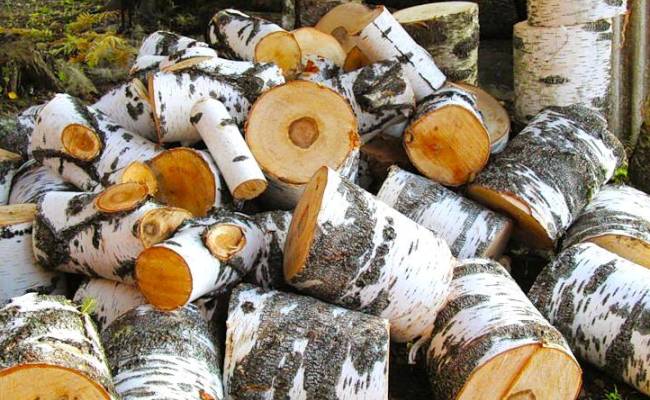
Harvesting birch firewood
A large amount of tar is present in the composition of birch wood and its bark. You can observe it during the combustion of the bark, when it begins to emit black clouds of smoke. Tar is a carbon compound, so it can catch fire instantly and burn with great intensity. At the same time, after combustion, there is practically no ash from the birch. Birch bark and wood splinters are often used for kindling stoves, since such wood burns even wet.
If we compare birch firewood and pine wood or with alder wood, then in terms of heat transfer they are 25-30% higher.
Alder firewood. Alder wood can be immediately recognized by its characteristic color, which can be orange, red, bluish, ocher. Different colours indicate a specific breed of alder, and at the moment there are about 20-25 of them. In ancient times, alder firewood was called "royal", since for many centuries it was used to heat the homes of the nobility.
Alder firewood has a wonderful property, it dries on its own under normal storage conditions. This property is most often characteristic of alder, which grew far from rivers, lakes, in soil with a small amount of moisture.
Another remarkable property of alder lies in its unique aroma, which the wood retains for 2-3 years of storage. After this time, the aroma during combustion will be negligible, but the level of heat transfer will not change. In ancient times, alder was actively used for heating baths in black, since it practically does not emit smoke when burned. It is believed that alder wood helps to clear the chimney from soot, emitting a certain type of fumes during combustion.
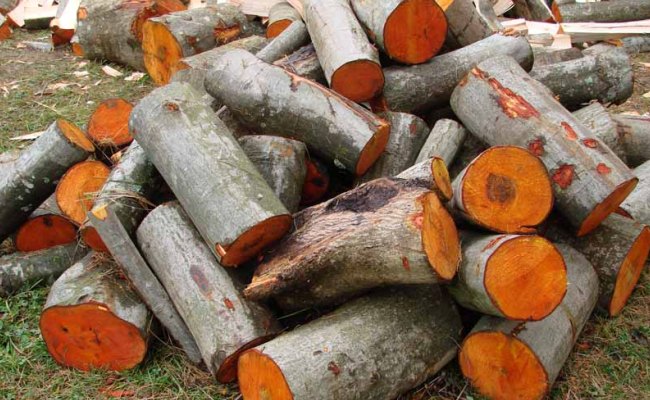
Harvesting alder firewood
Possessing a unique aroma, alder is actively used when smoking meat and fish, not without reason when harvesting alder, sawdust is collected for future use.
Ash firewood. Ash wood is rarely found on sale and is expensive, since in terms of its heat transfer this type of wood is comparable to oak, and even slightly surpasses it. Ash is harvested with certain problems, because of its solid structure it is very difficult to saw it into pieces.
Note that ash burns perfectly even wet, while it does not spark and gives a uniform flame. Use ash or birch if needed. If you come across such firewood on affordable price, be sure to purchase them.

Scarce ash firewood
Linden firewood. Experienced owners can use linden wood for quick kindling of stoves. The wood of this tree is quite difficult to set in a fire, but then burns very intensely, giving off a large amount of heat, which contributes to the rapid heating of the stove. This property is perfect for wood for a bath, the main task of which is to prepare excellent conditions for relaxation in a short time.
In addition, like birch wood, linden has healing properties, it helps with colds and respiratory diseases. It is believed that if you add a few tablespoons of honey to the linden tree, the resulting combined aroma and steam will heal old, poorly healing wounds.
Linden firewood does not lose its properties for about two years after cutting the tree. In the third year, the medicinal and thermal characteristics of wood gradually fade away.
Aspen firewood. Aspen firewood resembles alder in its functionality, at least they also effectively fight soot in the chimney. When burned, aspen practically does not emit smoke; characteristic steam comes out of it. This steam has a beneficial effect on the soot, which softens and leaves the walls of the chimney. When burning aspen wood inside the stove, you can hear soot falling into the firebox or blowing.
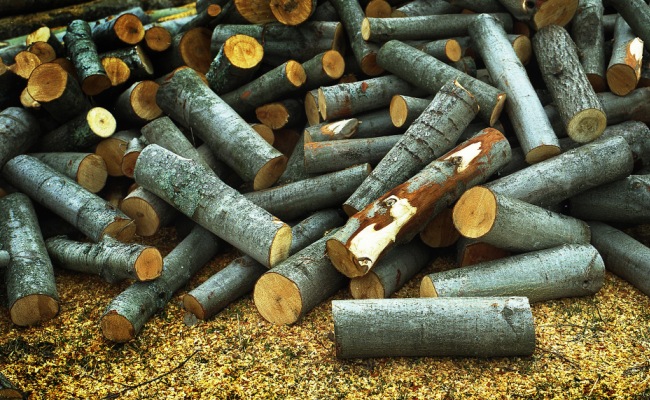
Harvesting aspen firewood
At the same time, the heat transfer from burning aspen is small and is unlikely to be sufficient for full heating of the room. Therefore, such firewood is used exclusively for preventive purposes. Aspen firewood for the stove will be extremely necessary if it was previously heated with conifers.
Willow and poplar firewood. Poplar and willow firewood have one drawback. They are rarely used for heating stoves, as they burn out very quickly. To heat a room with such wood, it is necessary to use a lot of them, so even a low, attractive price is not able to focus attention on them.
Experts have long ranked willow and poplar firewood as low-grade, which are used in rare cases when there is no normal wood species available.
Firewood from fruit trees. Firewood from fruit trees is not often found, but according to their characteristics, they are very good. Such wood in the stove will easily warm the house, but most often this wood is used for fireplaces or smokehouses due to their exclusivity. To meet such firewood is a rarity, because most often they appear after the cutting down of old gardens.
Coniferous firewood
Softwood contains a large amount of resin, which contributes to a fast and intense combustion with a lot of smoke and soot. Regular use of coniferous wood contributes to the formation of thick layers of soot on the walls of the chimney.
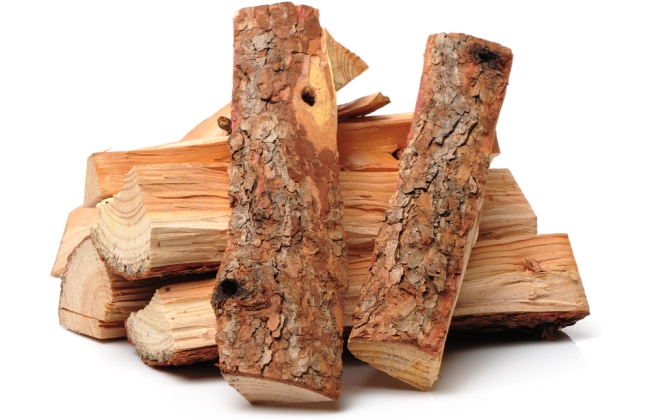
Coniferous firewood logs
That is why coniferous wood is practically not in demand for heating houses; it is used for kindling stoves in baths. The melted hearth with pine needles fills the steam room with a classic spruce aroma, which soothes the nerves and has a beneficial effect on the respiratory system. The forest coniferous aroma appears due to the essential oils present in the needles. When burned, spruce and pine firewood emits a characteristic crackling sound that many people like.
Note that burning coniferous firewood is difficult to extinguish, and the embers flying out of them make this wood the most fire hazardous. Therefore, it is best to heat a closed stove or fireplace with pine or spruce wood.
After analyzing all existing species wood, you can easily find the best firewood for heating stoves in your home and baths. Use different types of trees, find the best solution for a specific situation. Enjoy the pleasant aroma, warmth and coziness that burning wood firewood gives you.
17.02.2013, 17:59
Hot and cold wood
Since the volume of the firebox in the stove is limited, a limited amount of firewood can be placed in it for one tab. You need to heat with dry wood, preferably with exposure for 2 years under a well-ventilated canopy and protected from rain and snow.
If you put only pine firewood in the firebox, then they burn together, quickly, but give little heat, since pine is much lighter than oak or birch, for example.
If you put the same volume of oak, hornbeam, acacia, birch, beech, apple, pear, cherry firewood in this oven, then they will give much more heat than pine or spruce or from larch. These are hot firewood, they burn longer and give more heat, since their weight is greater for the same volume.
Hard species include white acacia, beech, cherry, hornbeam, pear, oak, dogwood, Karelian birch, juniper, walnut, boxwood, pistachio, yew, elm (elm), and some rare species. The firewood from these trees is hot and gives a lot of heat when the furnace is properly filled.
Soft species include linden, poplar, alder, aspen, willow, spruce, cedar, pine.
Common birch is in the middle position.
Pine, spruce, larch, willow give a little warmth. Conifers generate a lot of soot deposits in the oven and in its heat exchange system, as well as in the chimney. Soot is dangerous in terms of fire, when it ignites, an explosion and destruction of the stove and chimney (especially asbestos-cement or metal) are possible. Coniferous firewood is prone to strong "shooting".
Birch gives much more heat than pine, but when it burns, tar is formed, which settles in the heat exchange system of the furnace and chimney. This mixture of tar, soot and various resins is even more fire hazardous than just dry soot from pine.
It is especially dangerous to heat the stove with birch or coniferous wood in a smoldering mode (clamped blower and smoke valve), which contributes to the active deposition of tar and tar on the inner surface of the stove and chimney. It is unrealistic to remove these resins mechanically. They impregnate the brick, a pungent creosote smell appears, it is impossible to live in such an unhealthy room, since creosote is not only smelly, but also carcinogenic.
Excellent hot firewood for a furnace is hard wood. Dry maple burns well and hotly.
In that problematic double-circuit furnace for 1 million rubles, the firebox was made from pine scraps, from which the house itself with an area of 200 m2 was built. Now, if you burn the same stove with hardwood firewood, the effect would be much better. Although the firebox of this stove was made including coal, which has a much higher calorific value than wood (pine). So the problem is not in the wood and coal at all, but in the stove.
By the way, it is difficult to burn coal on the hearth. He needs a grate and regular skins, then he burns well.
The hearth in the firebox of this stove is a new-fashioned Canadian thing that did not justify itself in this stove, since firewood of a strictly defined length is needed and this firewood must be laid horizontally along the firebox, which worsens its combustion.
In this stove, due to the draft, the air through the narrow and small grates in front and behind the hearth is immediately carried up the furnace and goes into the hoods, and little air remains in the firebox for burning wood. The combustion is squeezed. It is necessary to put a grate of a much larger size for such a powerful stove so that the air passes through the thickness of the firewood and contributes to their good combustion.
You also need to use dry hardwood firewood instead of coal, which can normally burn only on grates with regular shuffling. At least the same birch, but better oak, hornbeam, beech, etc.
Viktorovich
18.02.2013, 18:34
Of course, an interesting excursion into the world of plants and trees. But in that part of Russia where such hot firewood is required, alas, they do not grow. And besides conifers, birch is a very trump wood. Well, it's true alder. She just used it to heat the Moscow cream. Royal firewood.
18.02.2013, 19:12
This means that in Krasnoyarsk you need to heat not with oak, but with pine, and not 2 times a day, but 4 times, since there are much fewer pine trees in the firebox.
19.02.2013, 02:41
Interesting text. Taken here (http://drovishki.ho.ua/styles.html).
The text is not mine! : grin:
How to correctly determine the amount of firewood?
* First, we need to understand what a warehouse meter is
(skl./m.). It's very simple, 1 meter high * 1 meter deep * 1 meter wide, densely stacked firewood. This is 1 floor / m2.
* And what is the difference between skl./m. and cubic meters / m.?
* By ordering firewood in cubic meters (cubic meters / m.),
conversion factor 0.7 from one word / m2.
* That is, 1 sq. / M2. This is 0.7 cubic meters.
* And if you have brought a car of firewood in bulk (in bulk), not stacked on the body.
* How to determine how many skl./m. or cubic meters / m.?
* By measuring the car firewood (in bulk), Length * Width * Height.
There is such a formula:
from embankment to slope / m. the conversion factor is 0.82. You multiply the volume of the body with firewood by 0.82 and you get the number of skl./m.
* Example:
GAZ 53 car
(in the technical passport there is no body volume, there is a carrying capacity of 5 tons.)
length 3.4 width 2.3 side height 2.0 m = 15.64 m3 (this is the maximum!).
And this car was pelted with firewood in bulk.
We take 15.64 and multiply by 0.82 = 12.8248 (up to thousandths +/-) sq / m.
Have you agreed to measure the volume in cubic meters / m3? Then multiply by 0.7 and get = 8.97736 cubic meters / m.
* This is how chopped firewood is measured. You were transported 15 cubic meters / m. but they brought ...
In this article I will try to briefly explain to you our current operating principle.
First * there is always at least 30 stock / m2 in stock. chopped firewood (hornbeam, ash). Why 30? The thing is that now many people have purchased solid fuel boilers, and these boilers cannot be heated with wood of natural moisture content (25-35%). When ordering firewood with a moisture content of up to 20%, we issue an invoice (we take an advance payment) and upon receipt of money, we load the camera within 2 days. Firewood dries from 10 to 15 days, depending on the temperature, wood species, moisture content of the firewood itself. After drying, the moisture content of the wood is 16-22%, this is normal. We load the truck awning and send the order to the client (if necessary, we give movers). Production is located 120 km. From Kiev (Obukhovskoe direction).
Second * to quickly close orders in Kiev, a ZIL dump truck 4 skl./m is working. (only oak and birch).
Third * What is new? This is a long forgotten old thing! How does Hornbeam burn? Twice as long as an oak! It doesn't burn, it smolders! And our ancestors knew this very well. The best wood for firewood (after Baobab). We deliver hornbeam chopped firewood.
But due to the fact that it is far and expensive for one person to carry a hornbeam, we ask you to find yourself a partner. 10 slopes / m. to each. Firewood is stacked on the body during loading, and a large KAMAZ, at a time, brings 18-20 skl./m. and with a trailer up to 30-32 skl./m. The larger the volume, the cheaper the transport. If you do not have such a partner, but have time, leave us a request and we ourselves will select a second client (within a week or two). 10 sq./m. hornbeam by the effect of efficiency = 20 skl./m. oak.
24.02.2013, 21:05
Hot and cold wood?
ZhP oak -70% - 840gr
Birch birch - 68% - 810gr
Pine ZhP - 52% -624gr
Aspen ZhP - 51% - 612gr
Alder fat - 46% - 552g
25.02.2013, 04:10
Hot and cold wood?
Generally, the heat output of firewood does not depend on the type of wood. From 1 kg of oak or alder, we get the same amount of heat (provided they have the same moisture content).
But still DI Mendeleev in his work "Fuels" (handbook of an engineer of those times) introduced the concept of firewood heat output. This is the temperature that can be obtained in the furnace when burning fuel. The heating capacity can also be determined in relative units.
The heat output of mountain maple is taken as a standard (100%) and burning firewood from this tree allows you to get a temperature of 1200g.
ZhP oak -70% - 840gr
Birch birch - 68% - 810gr
Pine ZhP - 52% -624gr
Aspen ZhP - 51% - 612gr
Alder fat - 46% - 552g
Hello chemists!
And you cannot find out for what conditions these numbers are indicated?
I once calculated the calorific value of wood according to Mendeleev's emiric formula. The calculation took minutes.
And then, based on the numbers received, he calculated the maximum combustion temperature - the calculation took about 2 days)))))
Since the maximum combustion temperature depends on many factors.
- the chemical composition of the fuel (it is considered the same for wood)
- humidity thereof
- excess air
- air humidity
- air temperature
- Atmosphere pressure
According to my calculations, the combustion temperature of pine is 30% humidity at an excess air ratio of 2, air humidity of 2% (rel) and a temperature of 0 * C and normal atmospheric pressure is 690 * C
and at an air and wood temperature of + 18 * C it will be 720 * C
This was confirmed by me experimentally (the thermocouple showed 680 * C) under approximately such conditions, taking into account that the walls of the firebox absorbed part of the energy.
And I can't understand how an oak washes to give more high fever than aspen with the same moisture content of wood ????
It is clear that the drying time and relative humidity, as well as the amount of calorific mass that we can stuff into the firebox, depend on the density of the wood. But how the combustion temperature depends, I cannot understand.
The only reason I can consider is the furnace voltage, which is the greater, the smaller the volume of the firebox. And since denser wood can be crammed into a smaller volume, then ...
But on the present stage, if you get low heat dissipation by the walls of the firebox (as was done in my stove), any wood can give the same maximum combustion temperature ...
Could you explain as a specialist to an amateur?
25.02.2013, 10:44
25.02.2013, 11:28
there is still a GRAB tree - it is even hotter than oak ........
And much more! They are heavier than oak and give such heat that the soul rejoices. : grin:
A hornbeam with a small addition of pine (spruce, larch) for lighting a hornbeam in a firebox gives a lot of heat with one laying. This is a very heavy and calorific firewood. Oak is significantly inferior, not to mention birch, and even more so pine.
25.02.2013, 11:39
I don’t know how much, but I burned 8 cubes of this hornbeam in my sauna stove....... and nothing - the stove "didn't choke" ..........
25.02.2013, 12:10
there is still a GRAB tree - it is even hotter than oak ........
By the way - I just ordered a typewriter (timber truck) of oak logs today - I will cook for next winter.
Sorry for the flood, but I can't resist ...
The timber carrier of Oak Logs is so exotic in our area!
Maybe it's better to cut a birch tree and burn it later?
Such is the rural arithmetic.
25.02.2013, 17:24
Thank you for responding to the message. The question of the heat output of firewood is very interesting. Topics have appeared on the "forumhaus", discussing the consequences of using "hot" firewood (oak, apple, parquet) and the so-called "euro wood" in metal ovens. This is warpage and burnout of furnaces.
The issue of firewood heat production was studied in the late 19th and early 20th centuries. In those days, not only home, but also technological ovens were heated with wood. Hence, Mendeleev's professional interest in firewood. I don’t know how exactly he measured the heat output. You need to look at the archives. But, keeping in mind that Mendelev was the director of the "Chamber of Weights and Measures", it can be assumed that there was a reference firebox, and the firewood was brought to a certain moisture content. At the same time, the data should have been useful to plant technologists, i.e. the oven is hearth, and the firewood is air-dry. It was not the temperature of the flue gases that was measured, but the object placed in the furnace.
25.02.2013, 18:44
See what you can do with your logging truck. True, in the pictures I also have mixed beech, ash, mahogany, walnut, maple ...
The cuttings burned gloriously, of course.
Honestly, I do not understand how you can burn oak if it is in the red book and the cube of this wood is very expensive.
I already told how an oak fell on a house during a hurricane and the victims sold it and repaired the house with this money))
Anatoly, for the parquet inlay - GREAT RESPECT !!!
As a child, I was engaged in veneer. It's good that there are still people who support these skills!
But not even absolute temperatures are important, but relative ones.
So in glass furnaces, a temperature of up to 1600g was needed. How was this achieved? Studying the work of Lomonosov on the production of glass and porcelain, I learned that ordinary firewood from the St. Petersburg province was used. Firewood was preliminarily dried in special ovens. Furnaces for melting glass were hearths made of Gzhel brick.
I am more than sure that heated air was fed into the firebox, I can even calculate to what temperature))).
Thanks!
The topic is really interesting, but it remained incomprehensible to me.
25.02.2013, 19:02
Not understood.
Anatoly Nikolaevich, so you are also a cabinetmaker at the same time, or what?))))
At one time, he was closely engaged in laying real parquet. What is in the pictures was done with only one jigsaw. Then the people were filled with ersatz parquet (laminate). This is a type of potbelly stoves among brick ovens. It became sad - went to the stoves ...
I see the difference, mainly, that dense firewood burns longer, that is, you need to throw it up less often.
Under Peter I, a head ax was made for a felled oak. It was the sovereign tree.
If we consider only the phase of fiery combustion of firewood, then in the same firebox, denser firewood gives more pyrolysis gases, i.e. combustion power increases.
26.02.2013, 03:15
But the combustion power can be increased by a finer splitting of wood.
For example, I only like the duration of the burning of hard rocks.
I drown the cherries and apple trees from my garden (the woodworm killed the branches).
... burns for a long time and gives the stove power evenly enough.
26.02.2013, 03:32
I see the difference, mainly, that dense firewood burns longer, that is, you need to throw it up less often.
There are more of them in the firebox (1 tab of firewood instead of two with one firebox), their calorific value is higher, they burn longer, dosed and not with the same torch as pine ones. Slow burning prolongs the process of burning wood, and this, in turn, has a very beneficial effect on the utilization of heat by an array of bricks that come into contact with the smoke.
Then there are stacks of uncleaned wood. They have a coefficient. styling from 0.4 to 0.6. Then there are stacks of assortment. It is already categorized in terms of quality and grade. There is a coefficient. sawlogs can be stacked up to 0.8, and firewood up to 0.6.
In general, at any stage, an experienced sizer can meet exactly 5%, with a tolerance of 10%.
26.02.2013, 13:03
Controversial statement.
For a potbelly stove - good, but for a brick oven, slow combustion will lead to overheating of the firebox area and a decrease in the efficiency of the convective system.
The smoke temperature during such combustion is higher than in the case of a strong supply of air to the blower for intensive combustion. In this case, the efficiency of heat recovery only grows and does not fall.
The firebox needs to be lined with chamotte, as the red solid ceramic brick begins to crumble in pieces.
26.02.2013, 13:53
It would seem that the answer to this question is simple: in central Russia, it is best to heat a bathhouse with dry birch wood, which is no more than three years... But if we discard mercantile considerations and add considerations of prestige, then our rating of firewood for Russia will look like this:
1. Alder firewood (royal firewood)
2. Oak firewood (princely firewood)
3. Birch firewood (merchant firewood)
4. Ash firewood
5. Linden firewood
6. Firewood from fruit trees (apple, pear, plum, cherry)
7. Willow firewood
8. Poplar firewood
9. Maple firewood
10. Pine firewood
11. Spruce firewood
12. Larch firewood
13. Aspen firewood
It is not in vain that alder firewood occupy the first place in our rating, since since ancient times they were considered "royal". According to historical rumors royal dynasty it was heated exclusively by alder. As far as the properties of firewood are concerned, it is very important that the alder grows on relatively dry soil. The advantages of alder firewood include the lightness and porosity of the wood, which dries quickly and flares up easily. Alder firewood practically does not deteriorate its properties during long-term storage.
Alder gives excellent heat and, due to its low resin content, practically does not emit smoke. Thanks to this, these woods are best suited for heating a smoke sauna.
The advantages of alder include its indispensability in smokehouses.
Gourmets believe that the best kebab is obtained on alder woods. And only alder firewood rightfully allows you to invite your guests to the "royal bath"!
In terms of heat transfer, alder is 1.3 times inferior to oak.
Oak firewood the highest quality obtained from middle-aged oak trees. Young oak trees give significantly less heat, and old rotten wood gives more ash than heat. The heat transfer of oak is the highest in our rating (only a few types of wood, such as hornbeam, for example, have a slightly higher heat transfer). Oak is the undisputed leader in fireplace inserts. They can also heat the sauna "in black" - a special forest spirit is guaranteed to you. By healing properties oak firewood also occupies a leading position. That is why we have assigned the title "princely" to oak wood.
Birch firewood.
The price-quality ratio of such firewood is just perfect.
Birch firewood is widely available and gives the excellent heat that defines the quality of bathing procedures.
Birch firewood allows you to heat the sauna both "white" and "black". Thanks to the birch bark, birch firewood is easily ignited and burns out evenly and keeps the heat for quite a long time, which disinfects the bathhouse well and has a wonderful aroma, which cannot be called otherwise than healing. Of course, over time (after two or three years), the aroma begins to lose its intensity, but in all other parameters, birch firewood does not lose its characteristics. In terms of heat transfer, birch is 1.1 times inferior to oak.
At the same time, in our rating of firewood for a bath, birch takes only the third place of honor. Thus, birch firewood deserves the title "merchant firewood".
Linden firewood. Due to the low density, linden firewood burns rather quickly, forms little coal and has a low specific calorific value (1.3 times lower than that of oak). The advantages of linden wood include an even heat and a healing aroma.
Firewood from fruit trees has an average heat transfer (1.2 times lower than that of oak), but it gives off a wonderful aroma. Wood is similar in properties to hardwood, so it is not easy to harvest such firewood.
Cherry wood is easy to chop, but difficult to light and smoke more than other fruit woods.
Of the entire fruit family, the apple tree will be the best - firewood burns without smoke and gives a fairly stable heat. In a word, firewood from fruit trees is exotic for amateurs.
Coniferous firewood (pine, spruce, larch) is at the bottom of our rating, since they emit carbon monoxide most of all when burned, have a relatively low heat transfer (about one and a half times lower than that of oak), crackle and spark strongly, and resin forms a lot soot.
Due to the abundance of resin, these woods are the most fire hazardous - they are the most difficult to extinguish.
It is not recommended to use such wood for heating the sauna "over black".
Despite these shortcomings, many people like the coniferous aroma, which has a life-giving effect on the respiratory system.
Softwood firewood keeps heat well and gives good coal. Pine wood is the hottest of all conifers.
Aspen firewood is poorly kindled, burns quickly and gives relatively little heat (the heat transfer of aspen is one and a half to two times lower than the heat transfer of oak). Our ancestors disliked aspen firewood and used it last.
If you are going to heat the stove with aspen wood, then it is better to put them in the stove, previously melted with other wood - the effect will be maximum. For aspen stakes, the 13th place in the ranking is the fairest result!
Firewood crackling in the fireplace or in the stove is always associated with warmth, comfort and peace. Burning wood differs from burning other fuels in its special appeal. If you share this point of view and use wood to heat it, it will be useful to learn about what types of wood there are, their features and which wood is best suited for heating a house.
Oak firewood is, first of all, a solid and valuable species of wood, and then firewood. Therefore, they are considered elite, which is reflected in their price. For example, real pizza is cooked exclusively on oak wood.
Middle-aged trees are chosen for firewood, then they burn longer and generate more heat.
A young oak gives little heat, in addition, the smell of embers will be felt in the house, but an old oak forms a lot of ash, and there is less heat from it and the air in the rooms becomes heavy.
For real good firewood from oak when burning, they fill the room with a tart smell and the aroma of forest freshness, strengthen health and increase tone.
The best firewood for a fireplace is oak.
Birch firewood is classified as hardwood and is considered one of the best options. Since in terms of calorific value they are only slightly inferior to oak and by 15 - 25% they are superior to pine and aspen firewood. In addition, they burn for a long time, do not spark and give an even flame.
But birch firewood also has a drawback - they contain a large amount of resinous substances, especially there are a lot of them in the bark, so it is not recommended to use bark for kindling. And birch firewood itself, when burned, emit a large amount of soot, which is deposited inside the chimney.
Throw in a few aspen logs to clear the chimney at the end of the firebox. During the combustion of birch wood, the room is filled with a unique fragrant aroma. Thus, the air is disinfected and people living in the house do not suffer from respiratory diseases. It should be noted that birch firewood that has been lying for more than two years gradually loses these properties.
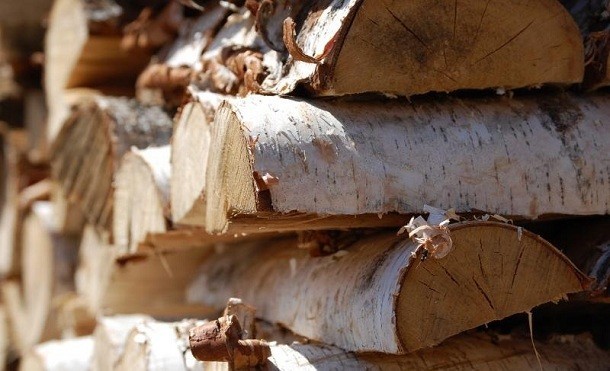
Alder firewood is called "royal". They flare up quickly, emit a lot of heat, they have a low resin content, so they burn practically without smoke. Alder is suitable for heating in a smoke sauna. And the aroma that is obtained during combustion has anti-cold properties.
If you start heating the house with alder wood, then its inhabitants will be vigorous and energetic all winter. Alder wood can be used to remove soot in the chimney after firing with pine and Christmas trees.
Alder firewood is also useful for cooking barbecue, and alder shavings and sawdust can be used to smoke meat and fish. Alder dries quickly in natural conditions and does not lose its aroma, even if stored for more than three years. 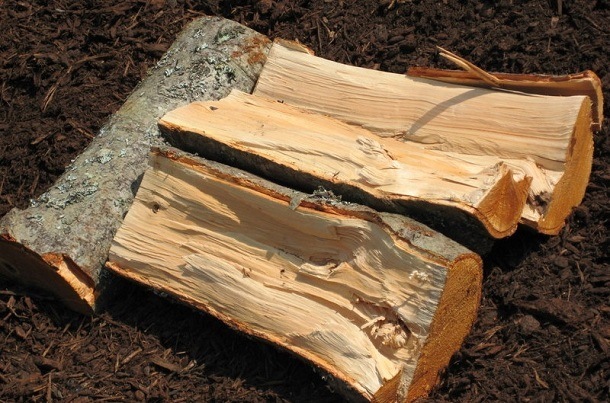
Aspen firewood is difficult to kindle and they give little heat, in addition, they burn very quickly. They have a bright long flame that does not smoke, which is why they are used to remove soot from the chimney. This firewood can be placed in an already melted oven, then it will keep the heat. 
Linden firewood
Linden wood is good for heating a sauna. Their sweetish aroma has a beneficial effect on the respiratory system. These firewoods are difficult to light, but their heat is persistent and long. Just like birch trees, they should not be stored for more than two years.
Pine and spruce wood can also be heated, but they contain a large amount of resinous substances. Pine will burn hotter than spruce due to its higher resin content.
When burned, these firewood crackles and "shoot" hot coals, so observe safety measures. Pine and spruce firewood emit an invigorating resinous scent essential oils and tone the upper Airways.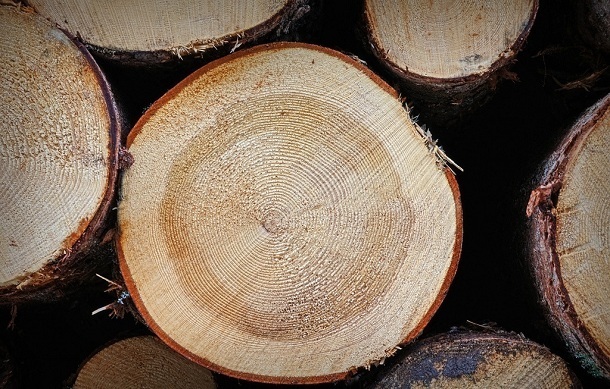
General requirements for firewood
Whichever firewood you prefer, it should be well dried, seasoned, logged last year. The logs should be the same size, not too thin or too thick, so more valuable ash will be produced.
Facts
Environmentally friendly ash is obtained from old, coarse wood and sawdust. Birch wood ash contains about 38% calcium, 15% potassium and about 8% phosphorus. Willow wood ash can contain up to 43% calcium.
The location of the felling affects the quality of firewood. On a dry area, firewood will be better than from wet lowlands, and firewood from trees grown on the side of the road is saturated with exhaust gases, used oil, gasoline and contains cadmium, lead and other toxic substances.
So what is the best firewood?
Since the calorific value of firewood is different, but they are bought in cubic meters, you need to strive to find logs with a high specific gravity... Ideally, these are birch firewood, although they cost an order of magnitude higher, for example, aspen. But on the other hand, in terms of calorific value, birch firewood is second only to oak firewood.
So 1 m³ of birch firewood corresponds to:
- 1.5 m³ - aspen firewood
1.3 m³ - spruce firewood
1.2 m³ - pine firewood
1.1 m³ - alder firewood
0.75 m³ - oak firewood
Obviously, the most profitable is oak firewood. But they are rare, and it is a pity to use this valuable wood for firewood, so instead of oak, it is better to use birch.
Not a single summer resident can do without firewood, especially in winter time of the year. Even if the cottage is heated with gas or electricity, there is a sauna and a fireplace. Firewood, of course, is different, and in order for the stove to warm up well and quickly and retain heat for a long time, you must definitely know which firewood is the hottest.
 There are few people who understand firewood. There are tree species that are suitable for construction, while others are excellent for heating. It should be borne in mind what exactly will be heated.
There are few people who understand firewood. There are tree species that are suitable for construction, while others are excellent for heating. It should be borne in mind what exactly will be heated.
For example, if wood is needed for a fireplace, then you should choose one that, when burning gives off a pleasant aroma... The composition of such wood should not include resin, otherwise a smoke effect will be created. Resin is found in conifers, so such wood is not used for a fireplace.
Good firewood should have excellent heat dissipation, do not smoke the room, completely burn out and do not leave behind a lot of waste. Fresh wood cannot be used for the firebox, because it will burn badly, because there is moisture in it.
The best quality wood is those that were cut down in winter. Indeed, during this period, there is very little juice in the trees.
The best fuel for the stove will be deciduous trees because they have a dense structure. Moreover, their main property is the duration of combustion, which means that the heat will remain for a long time. These tree species include linden, ash, oak, birch, aspen and others.
Birch and oak firewood
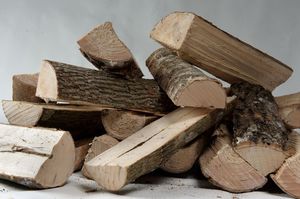 Birch trees are the most traditional for a stove or bath. They ignite easily and burn for a long time, and also do not release sparks at all. But, besides this, birch firewood disinfects the air, and the room is filled with a pleasant smell. Birch wood appreciated by bath lovers.
Birch trees are the most traditional for a stove or bath. They ignite easily and burn for a long time, and also do not release sparks at all. But, besides this, birch firewood disinfects the air, and the room is filled with a pleasant smell. Birch wood appreciated by bath lovers.
It is worth considering that you should not store firewood for a long time, because they quickly lose their qualities and deteriorate. Such trees have their disadvantage: in the tree structure a lot of tar, which leaves soot in the chimney and walls of the stove. If it is not cleaned in time, the likelihood of fire increases.
Oak firewood burns for a long time and therefore have good heat dissipation... Wood of this type is expensive, but at the same time its consumption for heating is less than other wood. When burning, oak wood thinns the tart forest aroma, therefore a healthy atmosphere is created in the room, because oak has medicinal properties.
For the firebox, you should choose medium oak, because young oak gives little heat, and old oak forms a large amount of ash when burning and has less heat transfer. The best firewood for a fireplace is oak.
Firewood from alder, aspen, linden, willow and fruit trees
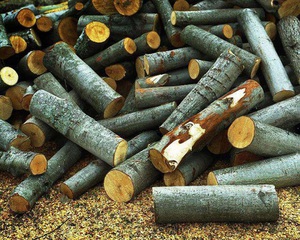 Alder firewood is orange and even red. The people call them royal, they have properties fire up fast, burn without smoke and have a low tar pitch.
Alder firewood is orange and even red. The people call them royal, they have properties fire up fast, burn without smoke and have a low tar pitch.
In winter, the residents of the house, which is heated with alder wood, will feel cheerful and energetic. But the main advantage of this wood is that it removes soot from the chimney walls.
Aspen firewood it is difficult to fire up than everyone else, and all because their wood is softer. However, they give little heat and burn quickly. But aspen firewood is distinguished by a bright and high flame, it does not smoke and helps to remove soot, which is their advantage.
Most often, aspen wood is placed in the stove next to other firewood so that they keep the heat. In the old days, the poor people had an aspen type of firewood. There is not much heat from them, but together with other types of trees, they retain heat longer, and plus they clean the chimney.
Linden firewood possess main feature- they are hard to ignite, but they burn intensely and the stove heats up quickly. In addition, linden has healing properties and most often this wood is used in baths.
In the old days, melting a bath with linden wood, honey was added to them so that the aroma heals old wounds and helps with diseases of the upper respiratory tract. And also a bath of them has a beneficial effect on the skin and quickly relieves a cold.
Willow firewood burn evenly, they are hot and do not smoke, but burn too quickly. At the same time, they have a low cost, but they are uneconomical to use. It is better not to use willow wood to warm up a large room.
Fruit trees also well suited for space heating. They quickly heat up the room and are most often used for fireplaces, because it is impossible to find such firewood on sale. Typically, this kind of wood is stored when cutting down gardens. But on the other hand, such trees have a pleasant aroma, but apple trees will fill the room with exoticism.
Varieties of conifers
Conifers include:
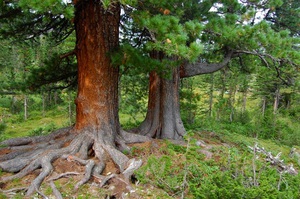
They are also used for heating, but the logs contain a lot of resinous substances. It should be noted that pine wood burns hotter than spruce, and all because of the large amount of resin. Keep in mind that this firewood can shoot while burning, so all safety precautions should be taken into account.
The advantages of these types of wood are that they emit an invigorating aroma of resin and essential oils which tones up the airways. It is best to use this wood in a sauna than for a fireplace.
After the firewood is ready, you need to take care of its storage. So that they do not lose their properties for a long time, they must be stored correctly. The place must be suitable to store the wood. To choose a woodpile, the following points should be considered:
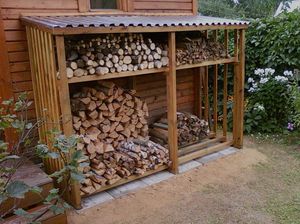
Many summer residents build a woodpile on purpose, and most use the old method - this is put all the logs in a common pile and cover them with large plastic bags. Which method to choose is decided individually, but it is best to choose the option that will preserve the wood for a long time.
And also do not use those trees that have been on the ground for a long time, because toxins accumulate in them. If you put the firewood in a woodpile correctly, then they will be stored for a long time and not lose their properties and qualities for several years.
For quick kindling of the stove, before stoking wood from the street should be brought into the house to warm it up. The speed of heating and preservation of heat in the room will depend on how the conditions for storing firewood were correctly fulfilled.
How to choose the right wood for a stove or fireplace
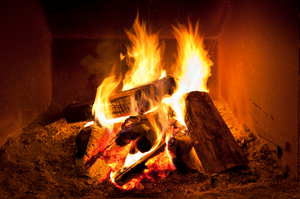 Among the variety of trees, it is difficult to settle for a certain type for heating a bath or fireplace. Each type of wood has its own properties and they are all practically the same, so this matter needs to be considered from a different point of view. To select, you need to find logs that have high specific gravity.
Among the variety of trees, it is difficult to settle for a certain type for heating a bath or fireplace. Each type of wood has its own properties and they are all practically the same, so this matter needs to be considered from a different point of view. To select, you need to find logs that have high specific gravity.
The ideal option would be birch trees, but they are more expensive than aspen, which are in second place after birch logs. But in terms of heat transfer, oak trees are superior to the rest. At the same time, it is difficult to find them; as a result, they can be replaced by aspen ones.
But the best option for the firebox is combined firewood, for example, you can melt a stove or fireplace with the help of apple or birch logs, then add aspen firewood there to heat the stove hotter, but in the bath you can put linden wood for healing.








